1. Let A, B, C be three 3 * 3 matrices with
entries from R such that
ABC + AB + BC + AC + A + B + C = O.
a) If A commutes with B + C then A commutes
with BC
b) If A commutes with BC then A commutes
with B + C
c) A + I is invertible
d) All of the above
Explanation:

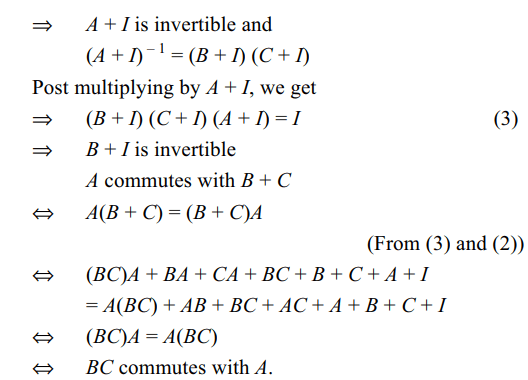
2. Suppose A, B are two distinct \[2 \times2\]
matrices such that
\[A^{2}-5A+6I=0\]
\[B^{2}-5B+6I=0\]
then
a) \[A^{3}-B^{3}=19\left(A-B\right)
\]
b) \[A^{4}-B^{4}=65\left(A-B\right)
\]
c) \[A^{5}-B^{5}=211\left(A-B\right)
\]
d) All of the above
Explanation: A3– B3 = (5A2– 6A) – (5B2– 6B)
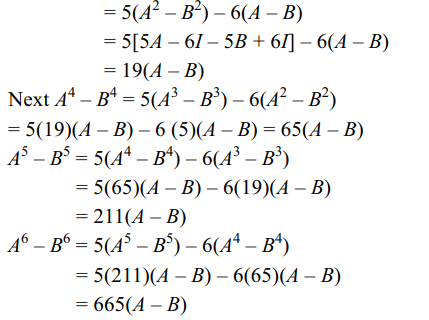
3. Let \[\omega\neq 1\] be cube root of unity and let
P = pij be \[n \times n\] matrix such that \[p_{ij}=\omega^{i+j}\] . Then \[P^{2}\neq O\]
when n is
a) 56
b) 55
c) 58
d) All of the above
Explanation:
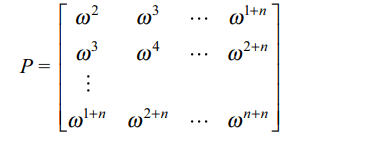
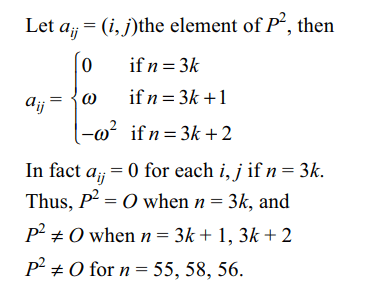
4. Let \[A=\left(a_{ij}\right)_{3\times 3},B=\left(b_{ij}\right)_{3\times 3}\] be two real
symmetric matrices such that \[A^{2}+B^{2}=O\] , then
a) AB = O
b) A = O
c) B = O
d) All of the above
Explanation:

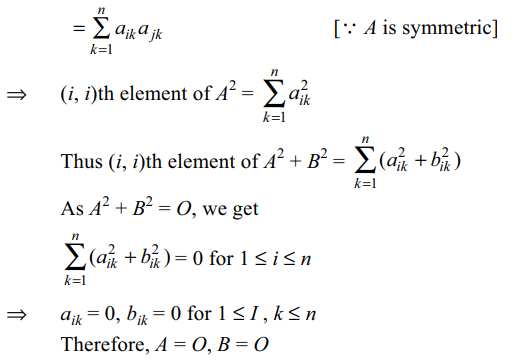
5. Let A be \[4 \times4\] matrix with real entries
such that determinant of every \[2 \times2\] submatrix is 0, then
a) adj(A) = O
b) det(A) = 0
c) AX = O has infinite number of solutions
d) All of the above
Explanation: As determinant of every 2 * 2 submatrix is 0.
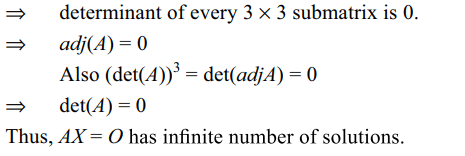
6. Let \[P=\begin{bmatrix}3 & -1 & -2 \\2 & 0 & \alpha \\3 & -5 & 0\end{bmatrix}\] ,
where \[\alpha\epsilon R\] ,
Suppose \[Q=\left[q_{ij}\right]\] is a matrix such that PQ = kI, where \[k\epsilon R,k\neq 0\]
and I is the identity matrix of order 3. If \[q_{23}=\frac{k}{8}\]
and det\[\left(Q\right)=\frac{k^{2}}{2}\] , then
a) \[\alpha=0 ,k=8\]
b) \[4\alpha-k+8=0\]
c) det(P adj(Q))= \[2^{9}\]
d) Both b and c
Explanation: PQ = kI
Q = (kI) P–1 = kP–1
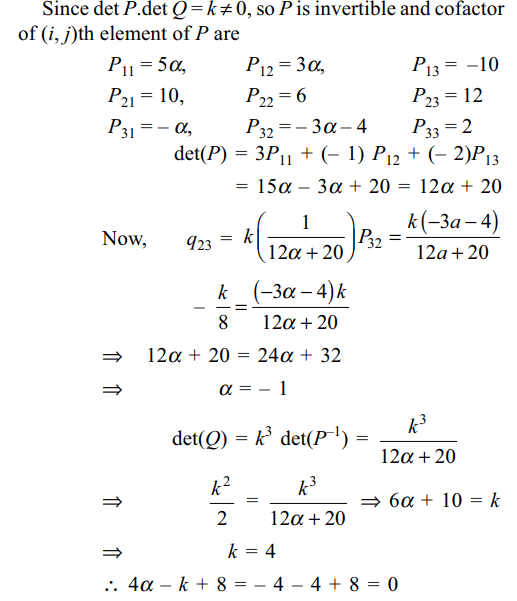
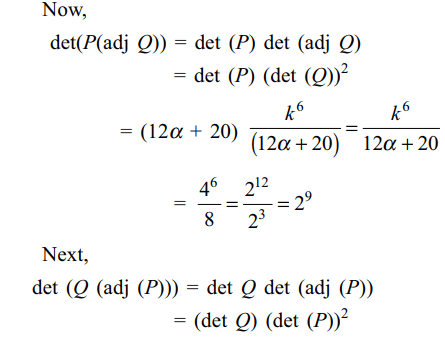
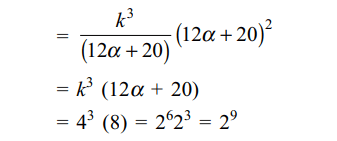
7. Let M be a \[2 \times2\] symmetric matrix with
integer entries. Then M is invertible if
a) the product of entries in the main diagonal
of M is not the square of an integer
b) the second row of M is the transpose of the
first column of M
c) M is a diagonal matrix with nonzero entries
in the main diagonal
d) Both a and c
Explanation: As M is a 2 × 2 symmetric matrix
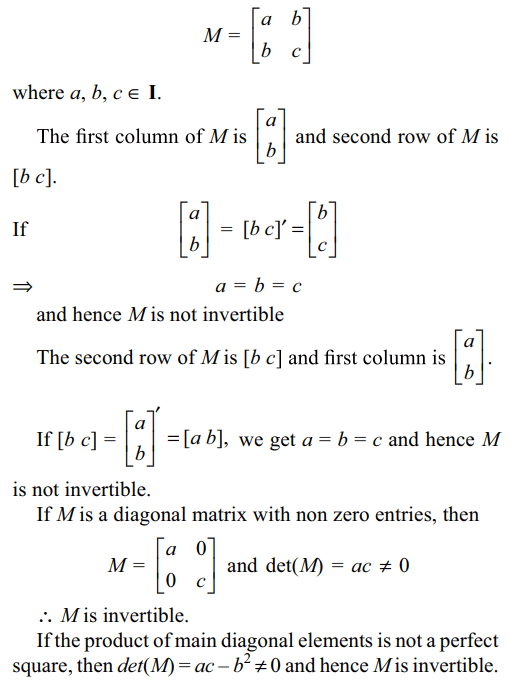
8. Let X and Y be two arbitrary, \[3 \times3\] , nonzero,
skew-symmetric matrices and Z be an arbitrary \[3 \times3\] ,
non-zero, symmetric matrix. Then which of the following
matrices is (are) skew symmetric?
a) \[X^{23}+Y^{23}\]
b) \[X^{44}+Y^{44}\]
c) \[X^{4}Z^{3}-Z^{3}Y^{4}\]
d) Both a and c
Explanation: X' = –X, Y' = –Y, Z' = Z

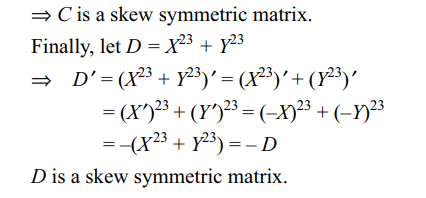
9. Let A, B be two \[2 \times2\] real commutative
matrices, such that det \[\left(A^{2}+AB+B^{2}\right)=0\] , then
a) \[det \left(A-\omega B\right)=0\]
b) \[det \left(A-\omega^{2} B\right)=0\]
c) \[det \left(A+ B\right)=0\]
d) Both a and b
Explanation: As A, B commute
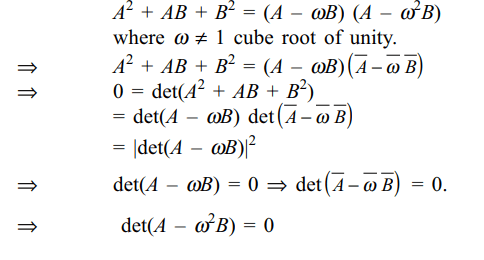
10. Let A and B be two matrices different
from I such that AB = BA and An – Bn is invertible for some
positive integer n. If \[A^{n}-B^{n}=A^{n+1}-B^{n+1}=A^{n+2}-B^{n+2}\] ,
then
a) I – A is singular
b) I – B is singular
c) A + B = AB + I
d) All of the above
Explanation:

